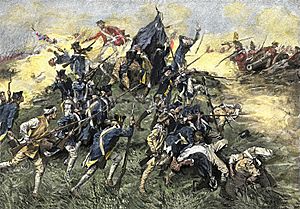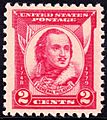Siege of Savannah facts for kids
Quick facts for kids Siege of Savannah |
|||||||
|---|---|---|---|---|---|---|---|
| Part of the American Revolutionary War | |||||||
 Attack on Savannah, by A. I. Keller |
|||||||
|
|||||||
| Belligerents | |||||||
| Commanders and leaders | |||||||
| Strength | |||||||
| Ground units: 5,050 Naval units: 42 ships |
Ground units: 3,200 Naval units: 8 vessels |
||||||
| Casualties and losses | |||||||
| 244 killed 584 wounded 120 captured |
40 killed 63 wounded 52 missing |
||||||
The Siege of Savannah was an important battle during the American Revolutionary War in 1779. It is sometimes called the Second Battle of Savannah. The city of Savannah, Georgia, had been taken by the British in 1778.
This battle was a joint effort by American and French forces to take Savannah back. It lasted from September 16 to October 18, 1779. On October 9, a big attack against the British defenses failed. During this attack, a Polish nobleman named Count Casimir Pulaski was badly wounded. He was leading the American cavalry (soldiers on horseback).
Because the attack failed, the Americans and French gave up the siege. The British kept control of Savannah until July 1782, which was near the end of the war.
More than 500 soldiers from Saint-Domingue (a French colony, now Haiti) fought with the American troops. These soldiers were led by French nobleman Comte d'Estaing. This was a very important help from other countries in the American Revolutionary War. Many of these soldiers were free men of color or enslaved people who hoped to gain their freedom by fighting.
Contents
Why the Battle Happened
After not doing well in the northern United States, British military leaders decided to focus on the southern colonies. They hoped to win over people in the South who supported the British, called Loyalists. Their first goal was to capture the important port cities of Savannah and Charleston.
In December 1778, the British easily took Savannah. The American militia and Continental Army there were not strong enough to stop them.
The American Continental Army gathered more troops. By June 1779, they had between 5,000 and 7,000 soldiers and militia in Charleston. General Benjamin Lincoln, who was in charge of these forces, knew he needed help from ships to get Savannah back. So, he asked the French for help. France had joined the war as an American ally in 1778.
French Admiral Comte d'Estaing was in the Caribbean with his fleet (a group of warships). He captured Grenada in July. Then, he agreed to help the Americans attack Savannah. On September 3, some French ships arrived in Charleston. They brought news that d'Estaing was coming to Georgia with 25 large warships and 4,000 French soldiers.
General Lincoln and the French leaders made a plan to attack Savannah. Lincoln left Charleston with over 2,000 men on September 11.
Who Fought in the Battle
The main groups fighting in the Siege of Savannah were the American Continental Army, French forces, and the British Army.
Allied Forces
The combined American and French forces were led by American Major General Benjamin Lincoln.
American Troops
The American forces included:
- Artillery (cannons) and engineers.
- Infantry (foot soldiers) from South Carolina and Georgia.
- Cavalry (soldiers on horseback).
- Militia groups from South Carolina and Georgia.
- Light troops for quick attacks.
French Troops
The French forces were led by Admiral Comte d'Estaing. They included soldiers from many different regiments (military units), including:
- Soldiers from France.
- Colonial regiments from French colonies like Saint-Domingue (Haiti), Martinique, and Guadeloupe. These included the brave recruits from Saint-Domingue.
- Artillery units.
British Forces
The British forces were led by Major General Augustine Prévost. They included:
- Regular British Army soldiers.
- Scottish soldiers (Fraser's Highlanders).
- Provincial troops (local soldiers who supported the British).
- German soldiers.
- Loyalist militia from South Carolina and Georgia.
- Royal Marines and naval gunners.
- Many cannons, howitzers, and mortars for defense.
British Defenses
The British had about 6,500 regular soldiers in the area. General Augustine Prevost was in charge in Savannah. When the French fleet arrived, Prevost quickly called back all his troops to defend the city.
Captain Moncrief of the Royal Engineers was in charge of building strong defenses. He used 500 to 800 African-American slaves to work up to twelve hours a day. They built a long line of trenches and redoubts (small forts) about 1,200 feet (365 meters) long, outside the city.
British Ships
The British Royal Navy had two older ships, HMS Foley and HMS Rose. They took the guns and most of the men from these ships to help fight on land. The British also used other armed ships and two galleys (small, oar-powered ships). They even armed two merchant ships to help defend the city.
The Siege Begins
Admiral d'Estaing started landing his French troops near Savannah on September 12. By September 16, they were moving into position around the city. D'Estaing was sure he would win. He thought that British reinforcements (extra troops) would not be able to reach Savannah. So, he asked General Prevost to surrender.
Prevost asked for a 24-hour truce (a temporary stop to fighting). There was a misunderstanding, and the waterways that could have stopped the British reinforcements were left unguarded. This allowed Colonel John Maitland and his troops to reach Savannah just hours before the truce ended. Prevost then politely refused d'Estaing's demand to surrender.
On September 19, French ships moved up the river and exchanged fire with British ships. The next day, the British sank their ship HMS Rose in a narrow part of the river. This blocked the channel and stopped the French fleet from getting closer to the city. The French ships could not help the American attack from the river.
The British ship Germaine took a position to protect the north side of Savannah's defenses. Other British ships helped fight against American galleys trying to bombard the town.
The French commander decided not to attack the British defenses right away. Instead, he took cannons from his ships and began to bombard the city. The city itself, not just the defenses, was hit hard by this bombing. It lasted from October 3 to 8. One British observer wrote that "hardly a house had not been shot through."
When the bombing did not work, d'Estaing changed his mind and decided to try a direct attack. He wanted to finish the operation quickly because his soldiers were getting sick, and supplies were running low. A long, traditional siege would have taken too much time.
The Attack on October 9
Against the advice of many of his officers, d'Estaing launched the attack on the British on the morning of October 9. The plan relied on surprise, but the British knew about it beforehand. Fog also caused some attacking troops to get lost in the swamps. The attack, planned for 4:00 AM, started late, almost at daylight.
The French admiral had chosen to attack a redoubt (small fort) that he thought was only defended by militia. But it was defended by both militia and tough Scottish soldiers. These Scottish soldiers had riflemen who easily shot the French troops. Admiral d'Estaing was wounded twice. The Polish cavalry officer Casimir Pulaski, fighting with the Americans, was also badly wounded and later died.
When the second wave of attackers reached the redoubt, the first wave was already in chaos. The trenches were full of dead bodies. Other attacks meant to distract the British were easily stopped.
A second attack column was led by the Swedish Count Curt von Stedingk. He managed to reach the last trench. He wrote later that he was happy to plant the American flag there, but the British fought back hard. He was forced to retreat with only about 20 wounded men left. He called it "the bitterest moment of my life."
After an hour of heavy fighting and many deaths, d'Estaing ordered a retreat. On October 17, Lincoln and d'Estaing gave up the siege.
After the Battle
The Siege of Savannah was one of the bloodiest battles of the war. The Americans and French lost many soldiers: 244 killed, almost 600 wounded, and 120 captured. The British had much lighter losses: 40 killed, 63 wounded, and 52 missing.
British leader Sir Henry Clinton called it "the greatest event that has happened the whole war." People in London celebrated when they heard the news.
The battle is remembered each year on General Pulaski Memorial Day in the United States.
Influence on Haitian Revolutionaries
The battle is very important in Haitian history. The Chasseurs-Volontaires de Saint-Domingue, made up of about 545 free men of color from Saint-Domingue, fought with the Americans.
Many of these soldiers later became leaders in the Haitian Revolution. This revolution led to Haiti becoming the first free black republic. Henri Christophe, who later became a king in Haiti, was 12 years old at the time and might have been among these troops.
Images for kids
See also
 In Spanish: Sitio de Savannah para niños
In Spanish: Sitio de Savannah para niños




